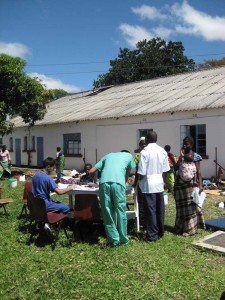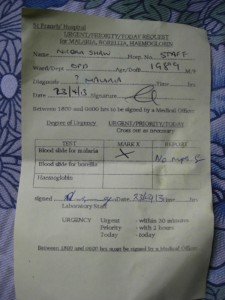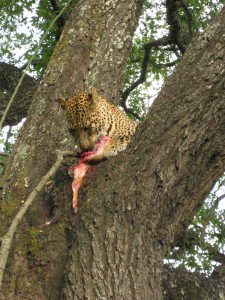So since last writing I have shifted onto Mbusa, the paediatric ward at St Francis Hospital.
Ward rounds here start off in SCBU, the special care babies unit. This area keeps premature / birth asphyxia babies in ‘incubators’ as they grow until they reach 1900g, which is discharge weight.
 SCBU is split into two rooms; room 1 for the babies under 1700g, and room 2 for those over. The incubators in room 1 are wooden boxes with lights and cups of water with cotton wool to add ‘humidity.’ The UV window for babies with neonatal jaundice is just the window in room 2, which gets the maximum hours of sunlight. Both of these rooms are artificially heated, which seems excessive on hot African days!
SCBU is split into two rooms; room 1 for the babies under 1700g, and room 2 for those over. The incubators in room 1 are wooden boxes with lights and cups of water with cotton wool to add ‘humidity.’ The UV window for babies with neonatal jaundice is just the window in room 2, which gets the maximum hours of sunlight. Both of these rooms are artificially heated, which seems excessive on hot African days!
(Particularly when you are unwell, which I was unfortunate enough to be when I started on paediatrics. Fortunately later that day it was confirmed that I did not have malaria!)
After SCBU, we move back to the main ward and start ICU ward rounds. While there are only seven beds in ICU, this is not the limiting factor on numbers. Often there will be 2 to 3 children to a bed. Sadly, many of these children regularly require urgent attention on rounds, ranging from needing fluid boluses for severe rehydration to CPR for cardiac arrests. It is heart breaking as you become attached to ‘your’ children on ICU, and often the outcome is not good.
One baby that stands out in my mind on ICU is a little girl who came to us when she was just four days old with neonatal sepsis. After going up and down clinically, requiring CPR once and ongoing nasogastric feeds / IV fluids, she finally started to improve. We were so excited, as she had been with us for three weeks with no change. But sadly on my last day, she developed a ileus, meaning that her body was finally starting to shut down, after having been in respiratory distress for so many days. She just couldn’t cope anymore.
 Watching parents wrap their children who have passed away in their chitenge and strap them on to their back, to carry them wailing home, one last time, is something that I will never forget. It was moving to watch all the mothers of the ward band together at times like that and walk the grieving mother out of the grounds in one big group.
Watching parents wrap their children who have passed away in their chitenge and strap them on to their back, to carry them wailing home, one last time, is something that I will never forget. It was moving to watch all the mothers of the ward band together at times like that and walk the grieving mother out of the grounds in one big group.
After ICU, we would move onto the main ward to the babies room and the ‘older’ children. You can only be 10 years or under to be on the paediatrics ward. Here we would have a great game of practicing our niyanga, much to the delight of the mothers around us. Particular bays of beds would take great pleasure in mocking us, and especially doctor Julie, with her characteristic Scottish accented “sorry, sorry, sorry.”
Unfortunately, many of the children have here have only been exposed to white people who are doctors. This means their instant expectation is that we are going to stick them with needles, and consequently burst into tears as soon as we either A) sit next to them, or B) touch them with our stethoscope.
There are definite exceptions to the rule, and often when children stop crying when you examine them, or smile, it means they are ready to go home. One child springs to mind; he came and jumped up on my knee, smiled, wrapped his arms around my neck for a big cuddle. Instant response was “you are totally ready to go home!”
 Once we finish in the main ward we move into malnutrition. Again, it is split into two rooms – into children in room 1 who are fed nutritional milk F75 (which is diluted down as they are not quite ready to handle full concentration) and room 2 where they are fed F100 and plumpy nut (calorie supplement).
Once we finish in the main ward we move into malnutrition. Again, it is split into two rooms – into children in room 1 who are fed nutritional milk F75 (which is diluted down as they are not quite ready to handle full concentration) and room 2 where they are fed F100 and plumpy nut (calorie supplement).
These rooms are both artificially heated as well, as one of the major killers of malnutrition patients is hypothermia. Malnutrition is probably the most heartbreaking place in the whole hospital. Children are swollen from lack of protein. Slowly though, their swelling goes down, and little by little they gain weight.
The mothers have great companionship, and take great pleasure in mocking us. It is always exciting the day you tell one of them they can go home, and watch the excitement for them go around the room. But equally it is sad when a child comes back for a second admission. It is difficult to convince parents that nshima (maize) is not the totally food requirements for a growing child.
Once we have finished rounds it leaves time to go and harass the lab for blood results and blood transfusions. We quickly learnt the fastest way to get what we wanted was to send me down there and refuse to leave until they gave me what I wanted. By my last day I could get a blood transfusion in 15 minutes. When I started it was an hour.
One day, the ward was being de-cockroached, and so we turned up for ward rounds, and found the entire ward had been moved outside. It was complete chaos! Patients came to us while we sat on a mattress, and we tried to invent some kind of system to make sure we didn’t miss people. Wearing sunglasses was definitely key! One of the doctors ended up with stethoscope burn lines around her neck though. It was hilarious!
But it hasn’t been all work. I was lucky enough to visit South Luangwa National Park. Here we saw hippos fighting in our garden, lions hunting a baby hippo, wild dogs take down an impala, leopards with a kill up a tree, along with giraffe, elephants and crocodiles. And a million other animals! It was amazing! Rosie came up from Lusaka to join us for her birthday, which was a great time to catch up with her too.
It seems crazy that I only have a week left in the hospital, before spending a few days down in Livingstone to see Victoria Falls and then finally flying home to New Zealand.

No comments yet.
Leave a comment